How to Draw a Giraffe Face Easy
Have you ever really wanted to draw a giraffe, perhaps for a loved one who is fanatical about these beautiful long-legged and long-necked creatures, but you simply do not know where to start? If this sounds like you, then you do not need to wonder anymore. With our detailed examples and in-depth instructions, you will soon be drawing giraffes without so much as a second thought. So, without further ado, let us jump right into our easy giraffe drawing tutorial!
Table of Contents
- 1 How to Draw a Giraffe Step-by-Step
- 1.1 Step 1: Constructing the Main Body Shape
- 1.2 Step 2: Placing the Giraffe Head
- 1.3 Step 3: Beginning to Draw the Giraffe Face
- 1.4 Step 4: Adding Horns and Ears to Your Giraffe Head
- 1.5 Step 5: Connecting the Giraffe Head and Body with the Neck
- 1.6 Step 6: Placing the Front Legs of Your Giraffe Drawing
- 1.7 Step 7: Drawing the Back Legs of Your Giraffe
- 1.8 Step 8: Outlining the Tail of Your Giraffe Drawing
- 1.9 Step 9: Creating the Final Outline of Your Easy Giraffe Drawing
- 1.10 Step 10: Creating the Signature Pattern Detail
- 1.11 Step 11: Adding Texture Throughout Your Giraffe Drawing
- 1.12 Step 12: Applying the First Coat of Color
- 1.13 Step 13: Adding Definition with the Second Coat of Color
- 1.14 Step 14: Adding Color to the Pattern
- 1.15 Step 15: Adding Depth to the Pattern
- 1.16 Step 16: The Final Shading Touches
- 1.17 Step 17: Adding the Finishing Touches to Your Giraffe Drawing
- 2 Video Tutorial for our Giraffe Drawing
- 3 Frequently Asked Questions
- 3.1 How to Draw a Giraffe for Beginners?
- 3.2 Is It Difficult to Draw Giraffe Eyes?
How to Draw a Giraffe Step-by-Step
As with any animal drawing, the toughest part of drawing giraffes is knowing where to start. In this tutorial, your drawn giraffe will begin with a few very simple construction shapes and lines. The construction method is particularly great for drawing giraffes because they have such unique proportions. With construction lines, you can make sure that the proportions of your drawn giraffe are perfect before you begin adding color and detailing. In the collage below, you can see each of the steps of this easy giraffe drawing tutorial.

For the coloring stages of your easy giraffe drawing, there is a lot of freedom for medium preference. Whether you love to work with oil pastels, on a graphic tablet, or you prefer the smooth glide of watercolor paints, you can easily adapt the instructions to suit your medium.
With that said, gather up your drawing tools and meet us somewhere comfortable to begin drawing giraffes.
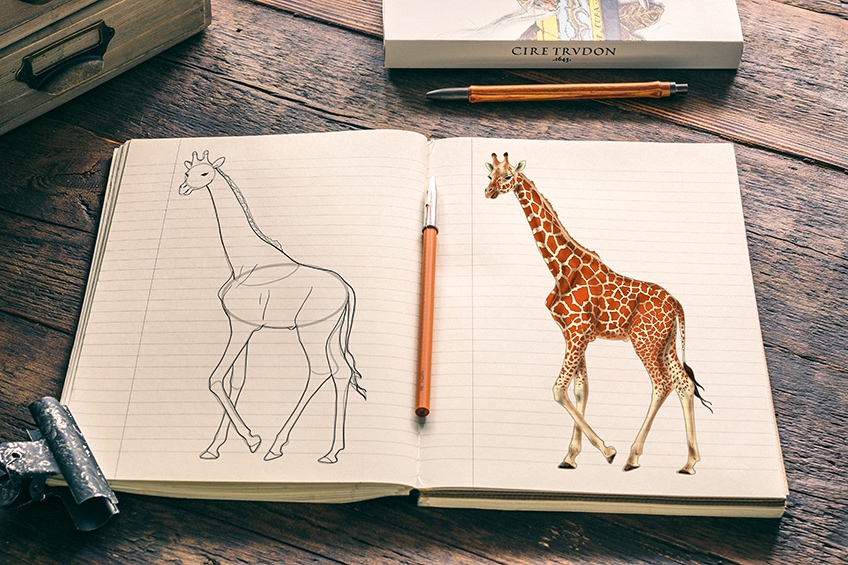
Step 1: Constructing the Main Body Shape
It is always best to begin a drawing by constructing the largest element. Having the largest part of your animal's body down on paper can make the placement of the smaller parts much easier. As such, let us begin by using a construction oval to represent the main torso of your giraffe drawing. This oval should be horizontal.
The most important thing to consider with this first step is the placement of your main body construction oval. Place this oval at the very center of your canvas, ensuring that there is plenty of space above and below for the long neck and legs.
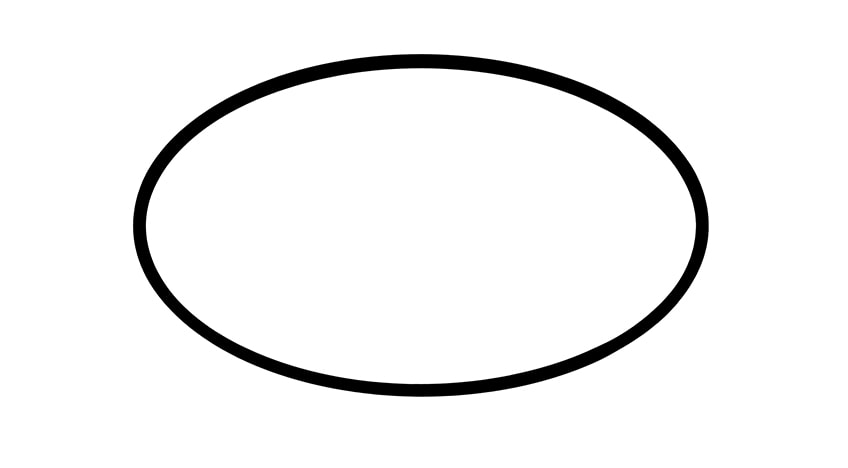
Step 2: Placing the Giraffe Head
Before we attempt to lay down the neck of your giraffe drawing, we will place the giraffe head in the top left corner of the canvas. Having the giraffe head placed on the canvas will make the construction of the neck significantly easier.
To the left of the main body oval, and a fair distance above it, draw a small circle to represent the giraffe head.
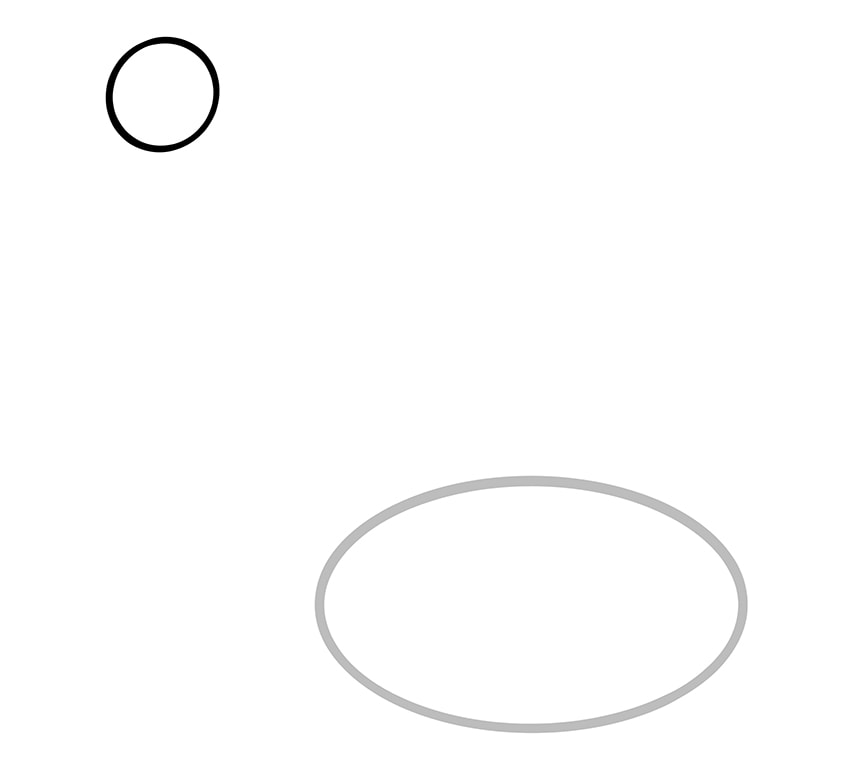
Step 3: Beginning to Draw the Giraffe Face
To begin laying the foundations for the giraffe face, we are going to construct the shape of the muzzle. Extending from the bottom left side of the head circle, draw a slightly pointed half oval shape.
This muzzle shape should be angled towards the bottom left corner of the canvas and will represent the nose of the giraffe head.
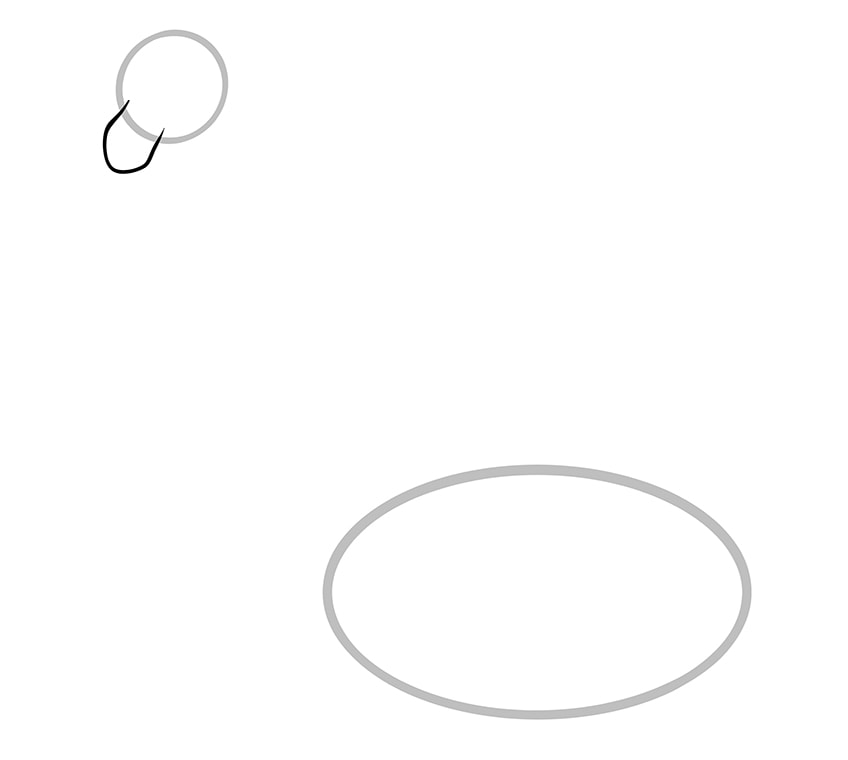
Step 4: Adding Horns and Ears to Your Giraffe Head
This fourth step in the easy giraffe drawing tutorial is very quick and simple. On the top of the giraffe head, draw a curvy "M" shape to represent the two short horns. On either side of the horns, draw a small curved ear.
The ear on the left of the canvas should be partly obscured by the horns, so you do not need to draw the whole ear.

Step 5: Connecting the Giraffe Head and Body with the Neck
In this step, you are going to use the shape of the giraffe's long curved neck to join the head and body. Begin at the giraffe head, taking the top neckline from the meeting point of the right ear and head circle. Gently curve this line up and then down to meet the body oval at the central point. For the underside of the neck, draw a straighter line down from the bottom of the head to meet the body oval.
Finish the giraffe's neck by joining the bottom points on the main body oval with a curved line.
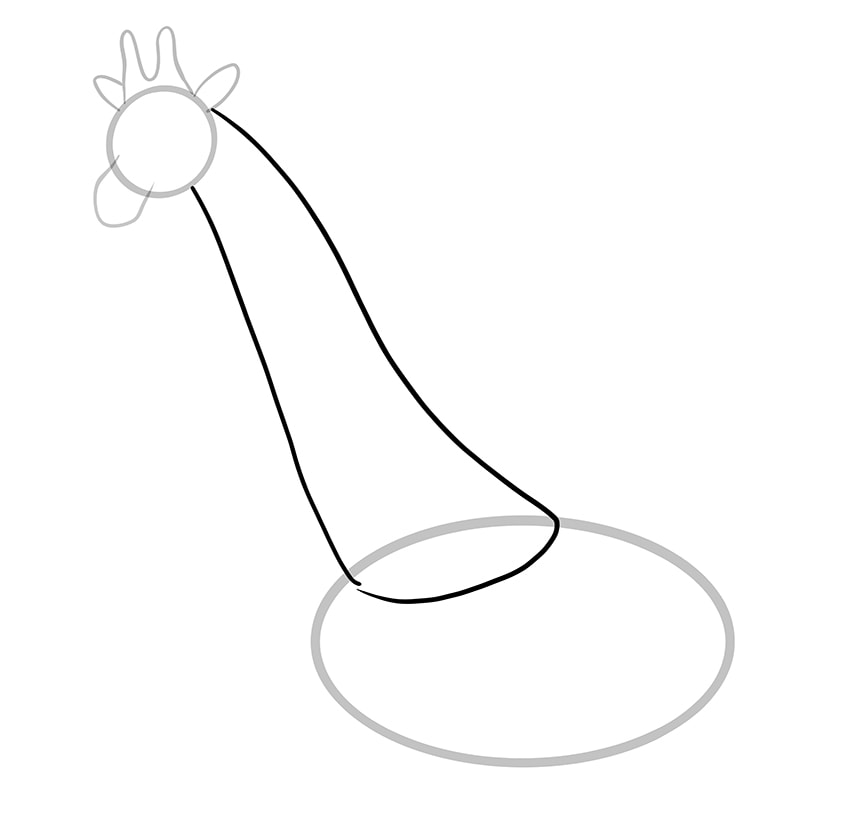
Step 6: Placing the Front Legs of Your Giraffe Drawing
On the whole, giraffes have very long and thin legs that look a little unsteady. To capture the movement of your giraffe, one of the front legs will be bent as if it is stepping forward. This bent leg is the one closest to our perspective, so we are going to draw this one first. Begin drawing the thigh segment of this first leg at the bottom of the left side of the main body oval. Curve the two lines in and down, and then create a rounded knee. At the knee, begin to separate the leg by drawing a straighter segment that extends towards the back of your giraffe drawing and ends in a hoof.
Repeat this process for the second leg, but remember that most of the thigh will be obstructed by the first leg and that this leg extends straight down.
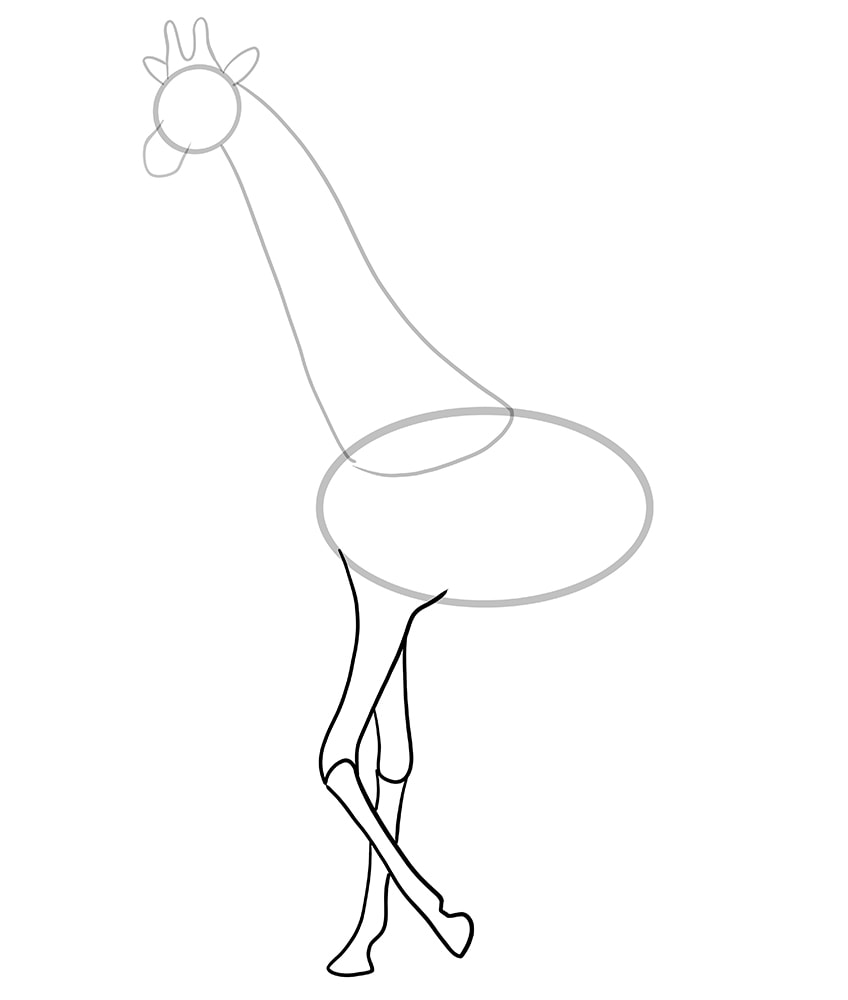
Step 7: Drawing the Back Legs of Your Giraffe
Once you have drawn giraffe legs once, it is very simple to draw the rest as they will all follow the same basic process. The notable differences to keep in mind with the back legs is that they are slightly thicker towards the top, and the thigh has a significant curve in the back. Begin by drawing the leg that is closest to our perspective, meaning you will draw the entire leg, with the back curve beginning at the back point of the main body oval. The knees for these back legs are higher and wider than the front ones. This first back leg will bend in the opposite direction to the front leg, with the hoof extending forward.
For the second back leg, simply repeat the process remembering that it will be partially hidden behind the first one and that it will extend straight down.
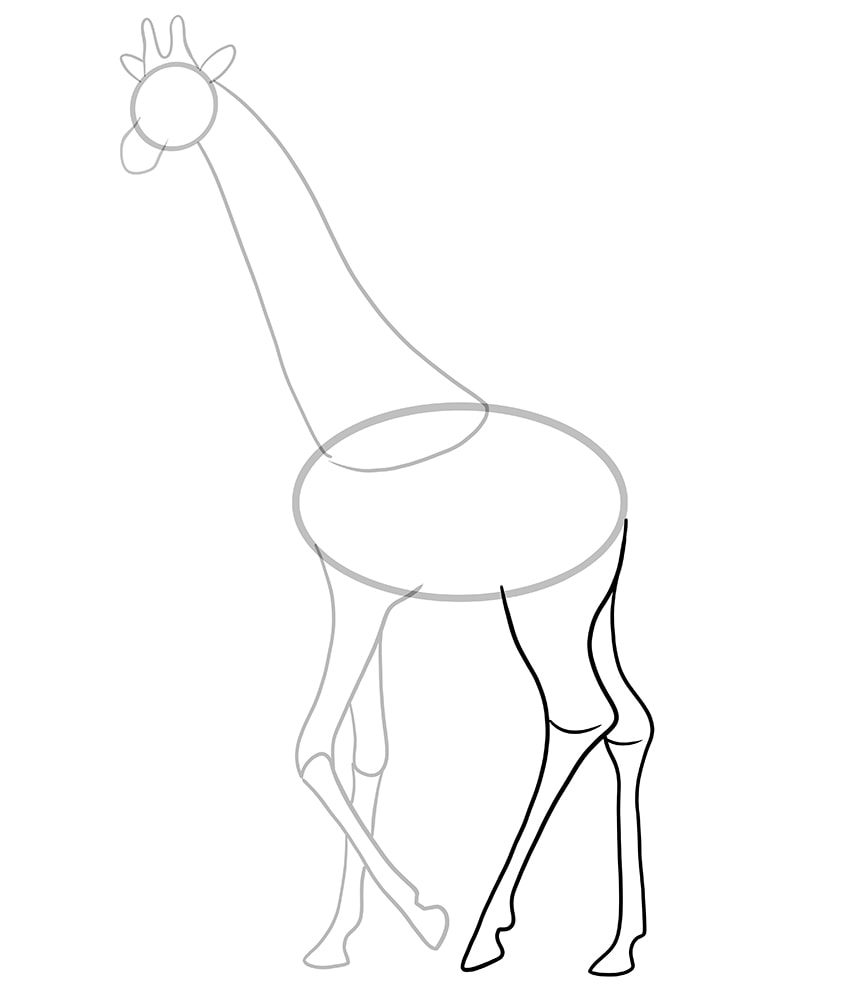
Step 8: Outlining the Tail of Your Giraffe Drawing
For this final construction step, you are simply going to draw the outline of the giraffe's tail. The tail is quite long, ending just below the knees of the back legs. Begin the tail outline at the back of the main body oval, and curve it down.
Finish the tail by adding a thicker end that is partially obstructed by the knee of the back leg.

Step 9: Creating the Final Outline of Your Easy Giraffe Drawing
The time for construction is over, and we are now going to use all of the foundational lines to create the final outline of our giraffe drawing. In this step, you are going to add details to the giraffe face, including the giraffe eyes and nostrils, and you are going to add details to the main, horns, and ears.
Begin at the head, following the outline of the construction lines and adding a little curve at the nose to create the mouth separation. Next, for the signature giraffe eyes, draw a little almond shape in the head and another half eye on the side. Add two little nostril shapes on the nose and add details to the horns and ears.
As you move down the neck, you can stick to the construction lines quite closely, but use the top outline as the mane outline. Add small horizontal lines to the main and make the edges a little jagged.
Continue to outline the body, adding little humps on the giraffe's backside, chest, and underbelly at the top of the legs. You can follow the outline for the legs and hooves quite closely, but do not add the separation line between the thighs and calves. Instead, you can add a small line to separate the hooves from the rest of the legs. For the final touch, add a realistic hairy tip to your tail.
When you are happy with your outline, you can erase any of the remaining visible construction lines.
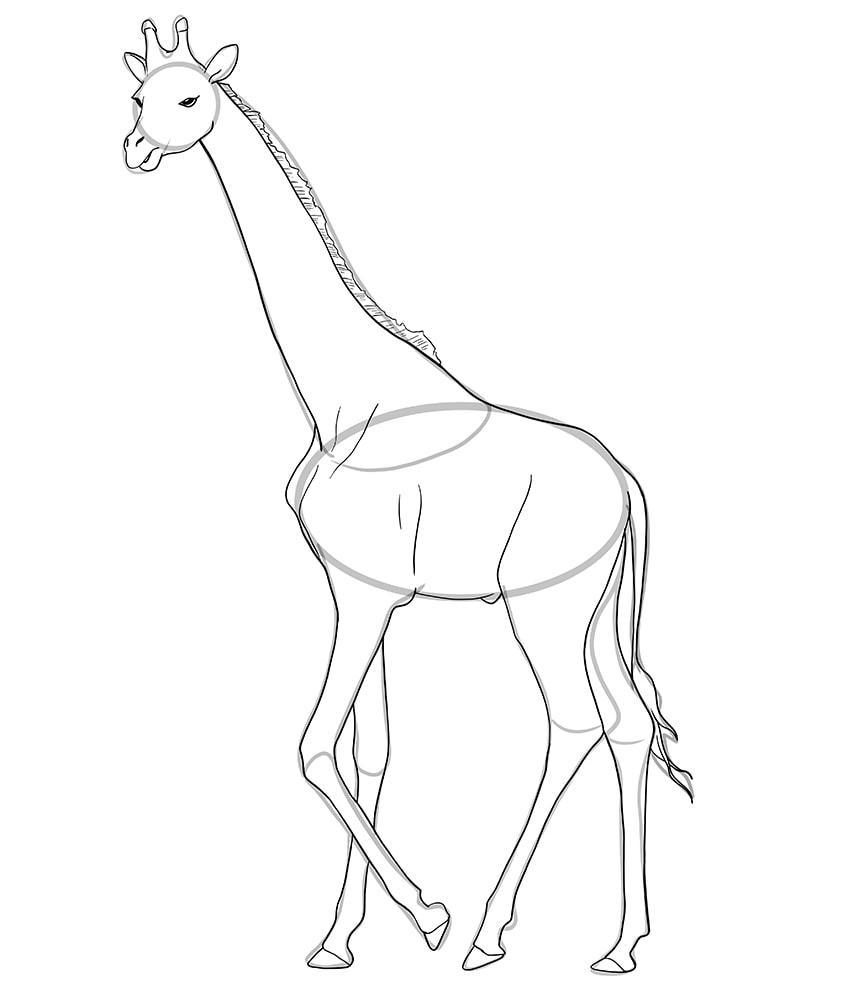
Step 10: Creating the Signature Pattern Detail
Now that you have the outline of your giraffe drawn, it is time to create that beautiful pattern. Begin at the face, drawing some small slightly geometric shapes around the eye and chin. Continue this pattern down the giraffe's neck, making the shapes slightly bigger as you move toward the chest. When drawing shapes around the edges of the neck, curve them slightly so that they appear to wrap around.
As you approach areas of the giraffe's body that are narrower, like the legs and tail, begin to make the pattern smaller. The pattern should also end just above the knees on all legs.

Step 11: Adding Texture Throughout Your Giraffe Drawing
In this step, use a few short texture lines throughout the body of your giraffe to add depth and texture.
Focus this shading around the horns, mouth, knees, hooves, and ankles.
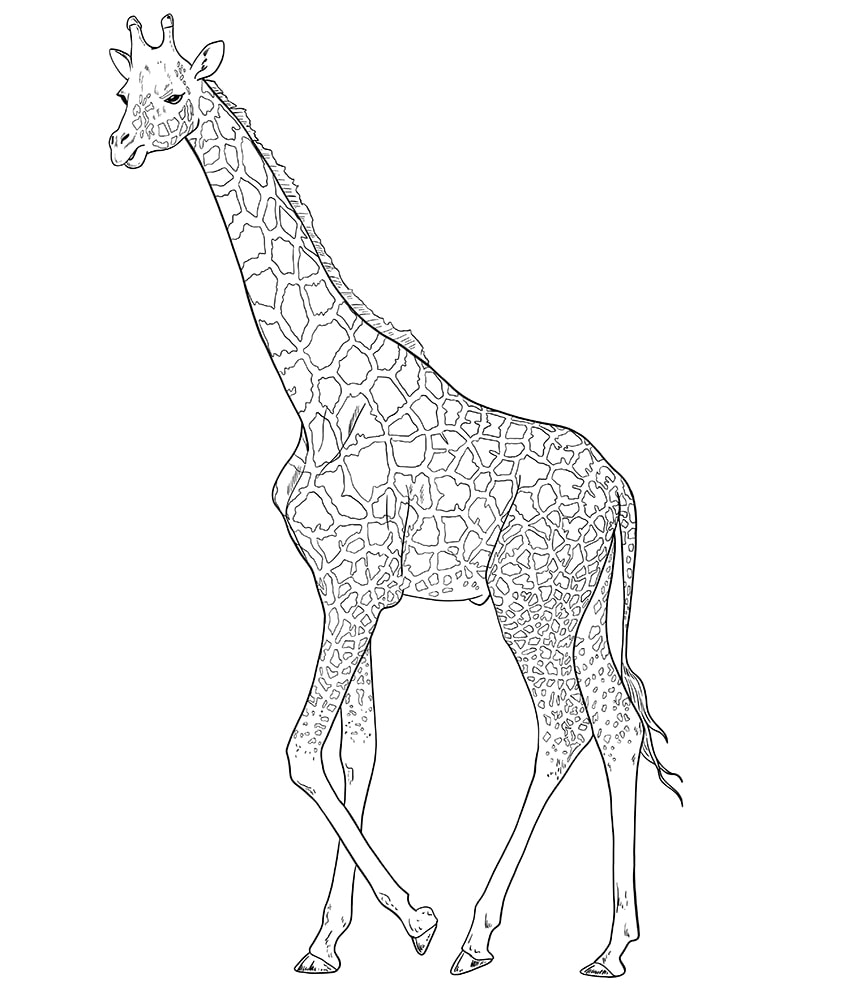
Step 12: Applying the First Coat of Color
If you take a look at the final giraffe drawing, you will notice that there is quite a lot of color variation in the coat. To achieve this look, we are going to build up the final color using several different layers.
For this first base layer. use a normal brush (or your chosen medium) to color the entire giraffe with a light yellow shade.

Step 13: Adding Definition with the Second Coat of Color
The second color you are going to use for your easy giraffe drawing is a light brown shade. Use this color to gently carve out the shape of your giraffe's body, adding depth to create a sense of three-dimensionality. Add brown to the horns and along the central ridge of the face. You can also color the tips of the main brown and add a stroke down the underside of the neck.
On the body, use the brown to mark out areas where the light would naturally miss, including the ridge behind the chest, along the belly, and in the grooves where the legs come into the body.
Use some more light brown sparingly to shade the top of the giraffe's back, the top of the tail, and the back sides of all of the legs. You can then finish this step by using a touch of black paint to color the tip of the tail and the hooves.

Step 14: Adding Color to the Pattern
In this coloring step, you are going to add color to all the shapes of the pattern we created earlier. The ideal shade for this step is a slightly burnt orange, as you do not want it to be too bright.
Using a fine brush and this color, simply fill in all the shapes of the pattern.

Step 15: Adding Depth to the Pattern
For this quick and easy step, you are simply going to use a small soft brush and a touch of black paint to add shading to the pattern shapes.
Make sure that you do not go too heavy with the black shading, as it can become overwhelming very quickly. You can always add more, but it is very difficult to take it away.
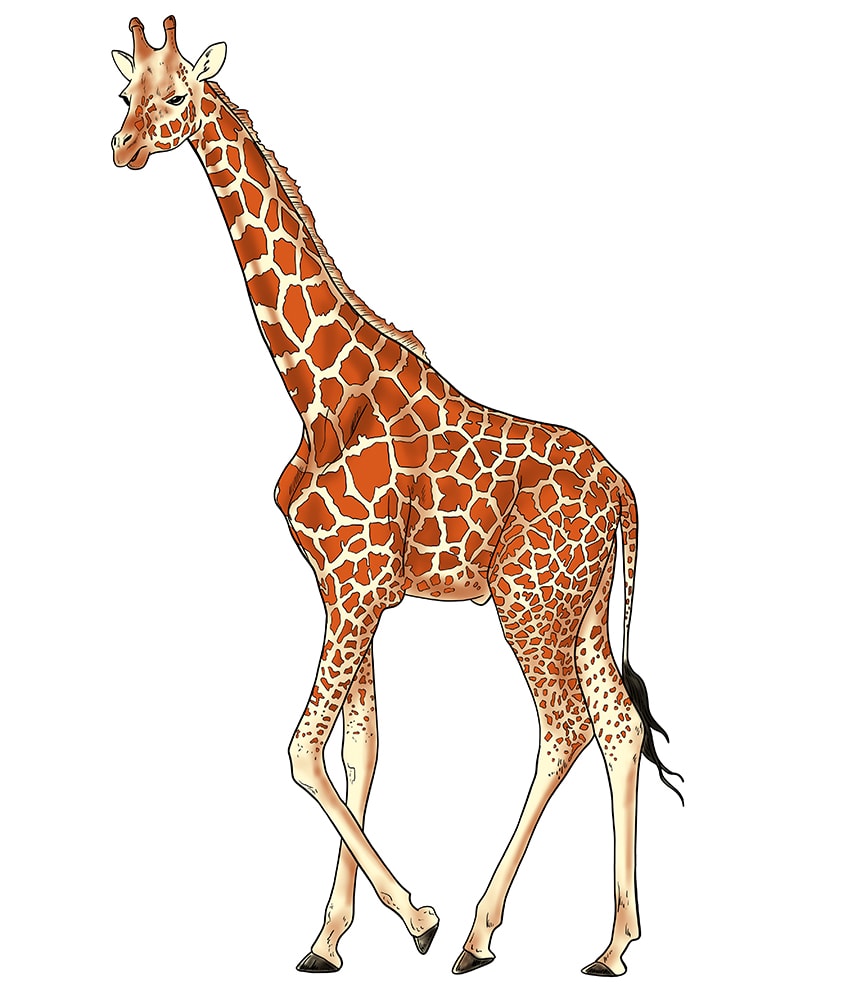
Step 16: The Final Shading Touches
In this final shading step, you are going to use a little more black paint and a small soft brush to add the final dimension throughout your giraffe drawing. Begin at the head, adding shadows to the nostrils, horns, ears, and other facial features. Continue down the neck, adding shadows where you would not expect natural light to fall.
For the rest of the body, use the texture lines you drew in step 11 as the central points of your shading within the legs.

Step 17: Adding the Finishing Touches to Your Giraffe Drawing
If you are happy with your giraffe drawing, then you can leave it as it is. If, however, you want a more seamless finished product, you can now erase the outlines. If you are using a graphic tablet, this step is little more than a click of your pen. For those of you using a more physical medium, you can simply use the corresponding color at each point of the outline to trace over it.
You can do the same for the detail lines within the body.
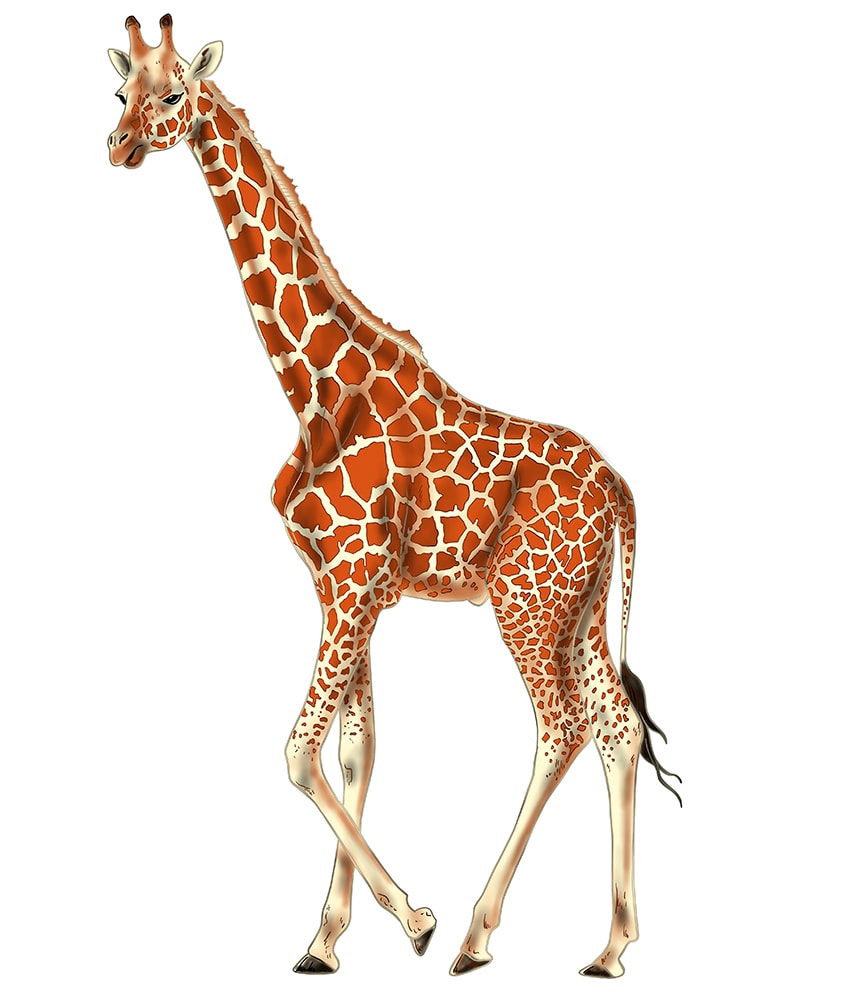
Hopefully you have enjoyed the drawing process of our easy giraffe drawing tutorial. You should now know the basics of how to draw a giraffe head, a giraffe face, giraffe eyes, and the full shape of a giraffe.
Video Tutorial for our Giraffe Drawing
Frequently Asked Questions
How to Draw a Giraffe for Beginners?
If you are an artist at the beginning of your journey, you may feel that creating a giraffe drawing may be too difficult. This is not true! With our easy giraffe drawing tutorial, you can learn the basic steps for drawing a giraffe and you can then use these concepts to learn how to draw a range of other animals too!
Is It Difficult to Draw Giraffe Eyes?
If you were to draw a giraffe face in more detail, there may be more to drawing giraffe eyes than we cover in this tutorial. However, the giraffe eyes in our tutorial are small, so you simply need to draw a small oval shape.
Source: https://artincontext.org/how-to-draw-a-giraffe/
0 Response to "How to Draw a Giraffe Face Easy"
Post a Comment